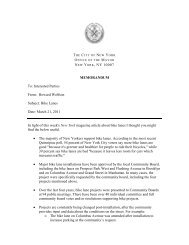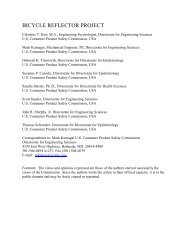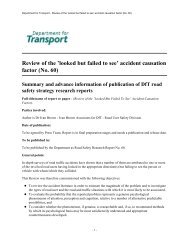Guide for the Development of Bicycle Facilities - The Industrialized ...
Guide for the Development of Bicycle Facilities - The Industrialized ...
Guide for the Development of Bicycle Facilities - The Industrialized ...
Create successful ePaper yourself
Turn your PDF publications into a flip-book with our unique Google optimized e-Paper software.
guide <strong>for</strong> <strong>the</strong> development <strong>of</strong> bicycle facilities 15<br />
Chapter 2 Design<br />
Design <strong>of</strong> new bicycle facilities, as well as improvements to existing facilities,<br />
is an ongoing process that should be consistent with a<br />
comprehensive plan considering <strong>the</strong> different bicycle users, existing<br />
conditions and community goals. A wide range <strong>of</strong> facility improvements<br />
can enhance bicycle transportation. An improvement can be simple and<br />
involve minimal design considerations (e.g., changing drainage grate inlets)<br />
or it can be more extensive (e.g., providing a shared use path). For<br />
example, improvements such as bicycle lanes depend on <strong>the</strong> roadway’s<br />
design. On <strong>the</strong> o<strong>the</strong>r hand, shared use paths are located on independent<br />
alignments; consequently, <strong>the</strong>ir design depends on many factors, including<br />
right-<strong>of</strong>-way, available funding, topography and expected use.<br />
A community’s overall goals <strong>for</strong> transportation improvements should include<br />
provisions <strong>for</strong> bicycle travel. Through appropriate planning and<br />
design, general improvements <strong>for</strong> motor vehicles can also be designed to<br />
enhance bicycle travel. For all roadways where bicycle travel is permitted,<br />
planning and design should consider provisions <strong>for</strong> bicycling.<br />
Roadway projects that extend near or intersect existing or planned<br />
shared use paths should include careful analysis and design measures to<br />
ensure <strong>the</strong> continued access and safety <strong>of</strong> path users. Public involvement<br />
in <strong>the</strong> <strong>for</strong>m <strong>of</strong> public meetings, hearings or bicycle advisory groups is encouraged<br />
during <strong>the</strong> planning and design processes.<br />
<strong>Guide</strong>lines are presented in this chapter to help design and implement<br />
bicycle facilities that accommodate <strong>the</strong> operating characteristics <strong>of</strong> bicycles<br />
as defined in this guide. Modifications to facilities (e.g., widths,<br />
curve radii, superelevations, etc.) that are necessary to accommodate<br />
adult tricycles, bicycle trailers, and o<strong>the</strong>r special purpose humanpowered<br />
vehicles and accessories should be made in accordance with<br />
<strong>the</strong> expected use, using sound engineering judgment.<br />
This chapter has been organized around <strong>the</strong> various classifications <strong>of</strong><br />
bikeways:<br />
❍ Shared Roadways<br />
❍ Signed Shared Roadways<br />
❍ Bike Lanes<br />
❍ Shared Use Paths<br />
❍ O<strong>the</strong>r Design Considerations<br />
Where guidelines overlap across classifications, reference is made to <strong>the</strong><br />
appropriate section to eliminate repeating text.<br />
Design





